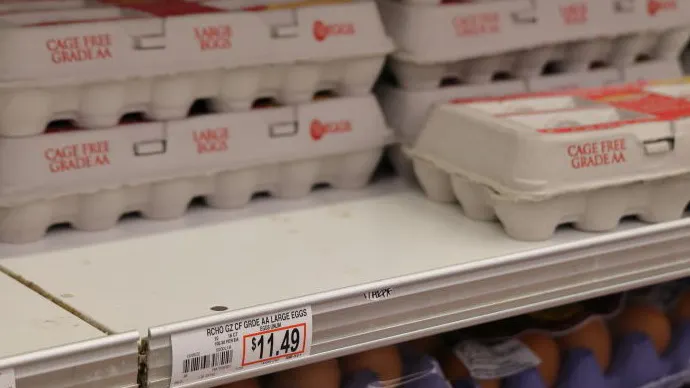A Washington Post columnist conducted a surreal exercise in absurdity this week to explain why eggs — which have soared 138% in price — are “cheaper than you think.”
Well, they’re not, really. Fact: the average price for large Grade A eggs was $4.25 a dozen in December, up from $1.79 exactly a year earlier, according to U.S. Bureau of Labor Statistics data. By the way, a dozen eggs cost just $1.33 in August 2020.
So, using advanced mathematics, eggs cost $2.46 more in December than they did a year ago.
But Megan McArdle, a Post columnist and the author of “The Up Side of Down: Why Failing Well Is the Key to Success,” worked some magic mathematics of her own. Unlike President Joe Biden, she did not blame “Putin’s price hike,” but explained that chickens have gotten sick and that’s leading to the higher price.
“The truth is that U.S. egg production is still recovering from a bout of avian flu that has devastated flocks in the United States and Europe,” she wrote. “And while activists and senators are puzzled by how a 29 percent decline in egg production can lead to a much larger increase in the price of eggs, agricultural economist Jayson Lusk says that’s exactly what you would expect with a product for which demand is relatively insensitive to price changes.”
Right. Twenty-nine percent drop in production, 138% rise in prices. Makes sense. Not. But hey, I’m not an agricultural economist.
Of course, everything’s more expensive due to inflation (McArdle points out a dozen eggs cost 25 cents in 1901). Yet she notes that modern production has reduced costs across the board.
“Almost all food items have gotten much cheaper, relative to our incomes, than they were a century ago. But some food prices fell faster than others, and chicken and eggs were among those that saw the greatest improvements, thanks to a combination of agricultural innovations,” she wrote.
Moving chickens indoors to protect them from predators and giving them artificial light to extend the laying season have led to greater production.
Finally, she makes this point: “But the benefits of this revolution have also been enormous. In 1905, an average male factory worker older than 16 took home $11.16 a week, enough to buy about 41 cartons of eggs. Today, the median man earns $1,176 a week, enough to buy more than 275 cartons of eggs, even at today’s elevated prices.”
She concludes: “If you can’t help cringing when you see the cashier ring up eggs that cost twice as much as they did a year ago, it might help to remember that however poor you feel, your ancestors would have taken one look at your grocery cart and declared you rich beyond their dreams,” she wrote.
Now, the Post’s motto is “Democracy Dies In Darkness,” but it’s hard to see the light in this argument. Yes, my great-grandfather would’ve marveled at the convenience of buying a bag of Doritos Flamin’ Hot Limon chips, but he would in fact cringe at the $5.59 price.
Farm Action, a farmer advocacy group, has a whole different theory for the price hike. The group says the “real culprit” behind sky-high prices is a “collusive scheme” among top U.S. egg producers to fix prices to gouge consumers.
In a letter to the Federal Trade Commission (FTC) last month, Farm Action said the alleged collusion has helped egg producers to “extract egregious profits reaching as high as 40%.”
And the letter said avian flu is not to blame.
“Examining publicly-available financial data from the egg industry, the letter determines that the supply disruption caused by the avian flu outbreak had an ‘apparently mild impact on the industry,’” the group said in a press release.
Plus, the group said egg producers like Cal-Maine are making money hand over fist.
“For the 26-week period ending on November 26, 2022, Cal-Maine reported a ten-fold year-over-year increase in gross profits — from $50.392 million to $535.339 million — and a five-fold increase in its gross margins,” the letter said.
And the group says “the real culprit behind this 138 percent hike in the price of a carton of eggs appears to be a collusive scheme among industry leaders to turn inflationary conditions and an avian flu outbreak into an opportunity to extract egregious profits reaching as high as 40 percent.”
“In the end, what Cal-Maine Foods and the other large egg producers did last year — and seem to be intent on doing again this year — is extort billions of dollars from the pockets of ordinary Americans through what amounts to a tax on a staple we all need: eggs,” the letter said. “They did so without any legitimate business justification. They did so because there is no ‘reasonable substitute’ for a carton of eggs. They did so because they had power and weren’t afraid to use it.”
So, to sum up, eggs are not cheaper than we think, they are, in fact, more expensive than they were (by the way, “thinking” about the price is pointless). And there’s not a scarcity because of avian flu, but rather, Farm Action says, collusion that’s driving up the price.
To paraphrase the Post’s motto: Democracy dies in dumbness.
The views expressed in this piece are the author’s own and do not necessarily represent those of The Daily Wire.
Joseph Curl has covered politics for 35 years, including 12 years as White House correspondent for a national newspaper. He was also the a.m. editor of the Drudge Report for four years. Send tips to [email protected] and follow him on Twitter @josephcurl.

.png)
.png)

